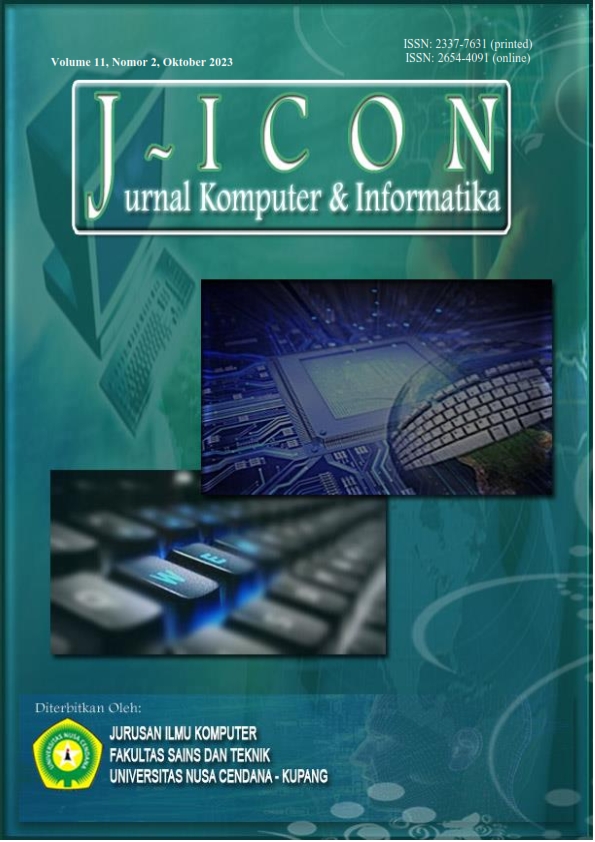KLASIFIKASI PENGEMUDI YANG TERDISTRAKSI DENGAN ALGORITMA SUPPORT VECTOR MACHINE BERDASARKAN PENGURANGAN FITUR PCA dan CNN
Abstrak
Penggunaan alat transportasi darat di Indonesia, terutama di kota-kota besar seperti Surabaya, mengalami pertumbuhan yang pesat. Namun, peningkatan penggunaan ini juga berdampak pada peningkatan kecelakaan lalu lintas. Salah satu faktor penyebab utamanya adalah distraksi yang dialami oleh pengemudi. Oleh karena itu, penelitian ini bertujuan untuk mengembangkan metode untuk mendeteksi pengemudi yang terganggu menggunakan teknologi klasifikasi gambar dengan model Convolutional Neural Networks (CNN) dan Support Vector Machine (SVM). Dalam penelitian ini, data diperoleh dari dataset "State Farm Distracted Driver Detection" yang berisi gambar-gambar pengemudi yang sedang berkendara dalam kondisi terganggu atau tidak fokus. Proses awal melibatkan pra-pemrosesan data, seperti mereskalasi ukuran gambar menjadi 50 x 50 piksel dan membagi dataset menjadi data latih dan data uji. Kemudian, ekstraksi fitur dilakukan menggunakan model CNN dengan tiga lapisan konvolusi, tiga lapisan Maxpooling, dan satu lapisan Flatten. Setelah ekstraksi fitur, metode Principal Component Analysis (PCA) digunakan untuk mengurangi dimensi data. Selanjutnya, model SVM dilatih menggunakan data hasil reduksi fitur oleh PCA dengan pembagian data yang digunakan adalah 60:40. Penelitian ini melakukan perbandingan antara menggunakan PCA dan tanpa PCA. Berdasarkan hasil pengujian, penggunaan PCA tidak hanya meningkatkan akurasi klasifikasi hingga 96.28% dibandingkan dengan 92.46% tanpa PCA, tetapi juga mempercepat waktu pelatihan menjadi 10.64 detik dari 19.67 detik tanpa PCA.
##plugins.generic.usageStats.downloads##
Referensi
H. Asyari, F. Maulana, K. Muhammad, dan R. Aulia Imran, “Pengaruh Driving Distraction Penggunaan Smartphone Terhadap Pengemudi Sebagai Penyebab Kecelakaan Lalu Lintas Dengan Multilevel Factorial,” Din. Rekayasa, vol. 18, no. 244159, hal. 99–108, 2022.
L. Lady dan A. Umyati, “Human Error dalam Berkendara Berdasarkan Kebiasaan Pelanggaran oleh Pengemudi,” J. Manaj. Transp. Logistik, vol. 8, no. 1, hal. 21, 2021, doi: 10.54324/j.mtl.v8i1.510.
N. C. for S. and Analysis, “Distracted Driving 2018,” Dot Hs 812 132, no. April 2020, hal. 1–7, 2020, [Daring]. Tersedia pada: https://crashstats.nhtsa.dot.gov/Api/Public/ViewPublication/812381
I. W. Agustin, C. Meidiana, dan S. Muljaningsih, “Studi Simulasi Model Kecelakaan Pengendara Mobil untuk Meningkatkan Keselamatan Lalu Lintas di Daerah Perkotaan,” War. Penelit. Perhub., vol. 32, no. 2, hal. 93–102, 2020, doi: 10.25104/warlit.v32i2.1513.
H. V. Koay, J. H. Chuah, dan C. O. Chow, “Convolutional Neural Network or Vision Transformer? Benchmarking Various Machine Learning Models for Distracted Driver Detection,” IEEE Reg. 10 Annu. Int. Conf. Proceedings/TENCON, vol. 2021-Decem, hal. 417–422, 2021, doi: 10.1109/TENCON54134.2021.9707341.
Q. Bu, J. Qiu, H. Wu, dan C. Hu, “Research on driver’s distracted behavior detection method based on multiclass classification and SVM,” IEEE Int. Conf. Robot. Biomimetics, ROBIO 2019, no. December, hal. 444–448, 2019, doi: 10.1109/ROBIO49542.2019.8961551.
NHTSA, “Research Note Distracted Driving 2021,” Dot Hs 812 132, vol. 2019, no. April 2015, hal. 1–8, 2023, [Daring]. Tersedia pada: https://crashstats.nhtsa.dot.gov/Api/Public/ViewPublication/812381
I. Goodfellow, Y. Bengio, dan A. Courville, Deep learning. MIT Press, 2016. [Daring]. Tersedia pada: https://www.deeplearningbook.org/
A. Hibatullah dan I. Maliki, “Penerapan Metode Convolutional Neural Network Pada Pengenalan Pola Citra Sandi Rumput,” hal. 1–8, 2019.
A. P. Sari, H. Suzuki, T. Kitajima, T. Yasuno, D. A. Prasetya, dan N. Nachrowie, “Prediction model of wind speed and direction using convolutional neural network - Long short term memory,” PECon 2020 - 2020 IEEE Int. Conf. Power Energy, hal. 356–361, 2020, doi: 10.1109/PECon48942.2020.9314474.
M. Z. Nasution, “Penerapan Principal Component Analysis (PCA) Dalam Penentuan Faktor Dominan Yang Mempengaruhi Prestasi Belajar Siswa (Studi Kasus : SMK Raksana 2 Medan),” J. Teknol. Inf., vol. 3, no. 1, hal. 41, 2019, doi: 10.36294/jurti.v3i1.686.
Adiwijaya, U. N. Wisesty, E. Lisnawati, A. Aditsania, dan D. S. Kusumo, “Dimensionality reduction using Principal Component Analysis for cancer detection based on microarray data classification,” J. Comput. Sci., vol. 14, no. 11, hal. 1521–1530, 2018, doi: 10.3844/jcssp.2018.1521.1530.
I. P. Monika dan M. T. Furqon, “Penerapan Metode Support Vector Machine (SVM) Pada Klasifikasi Penyimpangan Tumbuh Kembang Anak,” J. Pengemb. Teknol. Inf. dan Ilmu Komput., vol. 2, no. 10, hal. 3165–3166, 2018, [Daring]. Tersedia pada: http://j-ptiik.ub.ac.id
N. Maulidah, R. Supriyadi, D. Y. Utami, F. N. Hasan, A. Fauzi, dan A. Christian, “Prediksi Penyakit Diabetes Melitus Menggunakan Metode Support Vector Machine dan Naive Bayes,” Indones. J. Softw. Eng., vol. 7, no. 1, hal. 63–68, 2021, doi: 10.31294/ijse.v7i1.10279.
M. Blondel, A. Fujino, dan N. Ueda, “Large-scale multiclass support vector machine training via euclidean projection onto the simplex,” Proc. - Int. Conf. Pattern Recognit., no. 4, hal. 1289–1294, 2014, doi: 10.1109/ICPR.2014.231.
K. Crammer dan Y. Singer, “On The Algorithmic Implementation of Multiclass Kernel-based Vector Machines,” J. Mach. Learn. Res., vol. 2, hal. 265–292, 2001.
B. P. Pratiwi, A. S. Handayani, dan S. Sarjana, “Pengukuran Kinerja Sistem Kualitas Udara Dengan Teknologi Wsn Menggunakan Confusion Matrix,” J. Inform. Upgris, vol. 6, no. 2, hal. 66–75, 2021, doi: 10.26877/jiu.v6i2.6552.
M. Anand, A. Velu, dan P. Whig, “Prediction of Loan Behaviour with Machine Learning Models for Secure Banking,” J. Comput. Sci. Eng., vol. 3, no. 1, hal. 1–13, 2022, doi: 10.36596/jcse.v3i1.237.
W. K. Anna Montoya, Dan Holman, SF_data_science, Taylor Smith, “State Farm Distracted Driver Detection,” Kaggle, 2016. https://www.kaggle.com/competitions/state-farm-distracted-driver-detection
I. O. Muraina, “Ideal Dataset Splitting Ratios in Machine Learning Algorithms: General Concerns for Data Scientists and Data Analysts,” 7th Int. Mardin Artuklu Sci. Res. Conf., no. February, hal. 496–504, 2022.
##submission.copyrightStatement##
##submission.license.cc.by4.footer##Penulis yang mengirimkan naskah harus memahami dan menyetujui bahwa jika diterima untuk diterbitkan, penulis memiliki hak cipta dan memberikan jurnal hak publikasi pertama dengan karya yang dilisensikan secara bersamaan di bawah Creative Commons Attribution (CC-BY) 4.0 License yang memungkinkan orang lain untuk berbagi karya dengan pengakuan kepenulisan karya dan publikasi awal dalam jurnal ini.
 Achmad Yuneda Alfajr(1*)
Achmad Yuneda Alfajr(1*)




